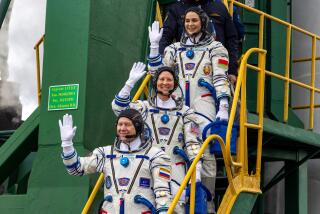Soviets Mark 25th Year of Manned Flights in Space
- Share via
STAR CITY, Soviet Union — The Soviet Union, which put the first man into orbit 25 years ago today, is celebrating the anniversary with a conviction that it will achieve further such feats.
It has sent into space a station that may orbit the Earth for 10 years, moving far ahead of the United States in this field.
Three of its cosmonauts have set an endurance record of 238 days in space, and it has carried out fly-bys of Halley’s comet that have added to man’s knowledge about the creation of the universe.
Renewed Soviet-American space cooperation on a trip to Mars in the 1990s is being discussed seriously here.
Becoming More Open
Moreover, the traditionally secretive Soviets have in recent months allowed the world a closer look at some of their space activities. The admission of two busloads of foreign journalists to the cosmonaut training center here underscores what appears to be a trend toward openness in the Soviet space program.
The foreigners were shown duplicates of Mir, the orbiting space station, and Salyut-7, another vehicle in space.
Despite a string of Soviet successes and the recent American disaster involving the space shuttle Challenger, Soviet officials were anything but cocky about making comparisons with the U.S. effort.
“It’s difficult to say that one country is ahead of the other,” said Gen. Georgy T. Beregovoy, commander of the Star City complex, which is situated not far from Moscow. “In some areas, the Americans are better, and the Soviet Union is better in other fields. Overall, there is general balance.”
Beregovoy, a former cosmonaut, said American superiority in electronics is evident, and the Soviet Union has done more to solve the problem of space sickness.
No Safety Guarantee
As for the Challenger explosion that killed all seven Americans on board, he said there is no guarantee of safety in any space flight.
When Mir was sent into orbit, the Soviet Union for the first time showed the launch on television. As it turned out, the launch was virtually flawless, but Beregovoy said there was “some percentage of risk.”
In another move toward openness, Western journalists were allowed into the mission control center near Moscow the other day for a radio interview with the two cosmonauts on board Mir.
And Izvestia, the official government newspaper, ran a series of articles with new disclosures about the early days of the Soviet space program, including the fiery death of cosmonaut Valentin Bondarenko in a training accident in 1961. Bondarenko’s death was not made public at the time, Beregovoy said, because officials were concerned about how the public might react.
Izvestia also gave new details of the first manned flight, by Yuri Gagarin, a 27-year-old fighter pilot. The newspaper said space officials were concerned that Gagarin might panic when he was rocketed into orbit on April 12, 1961, so they prevented him from having access to a backup manual control system without knowing a special code. But at the last minute, Izvestia revealed, a friendly technician leaned into Gagarin’s capsule and told him, “Yuri, the code is 1-2-5. Got it?”
Legendary Figure
Gagarin, who was killed in a 1968 plane crash, has become a legendary figure in the Soviet Union. His cosmonaut successors pay homage to his memory before each launch by placing flowers at his larger-than-life statue in Star City. Once they return safely, they return to place fresh flowers.
Gagarin’s flight, four years after the Soviets startled the rest of the world by launching Sputnik, the first artificial satellite, triggered America’s successful man-on-the-moon project.
Moscow decided not to compete in the moon race, but it beat the United States to the punch in launching a long-term space station. And Soviet cosmonauts have logged more than twice as much time in orbit as their American counterparts.
Beregovoy said that Mir--the word means peace--is 20 meters in length, weighs 20 tons and is capable of docking six modules weighing an additional 110 tons.
He said 59 Soviet cosmonauts are in training at the center, along with 11 others from Communist countries.
More to Read
Sign up for Essential California
The most important California stories and recommendations in your inbox every morning.
You may occasionally receive promotional content from the Los Angeles Times.













